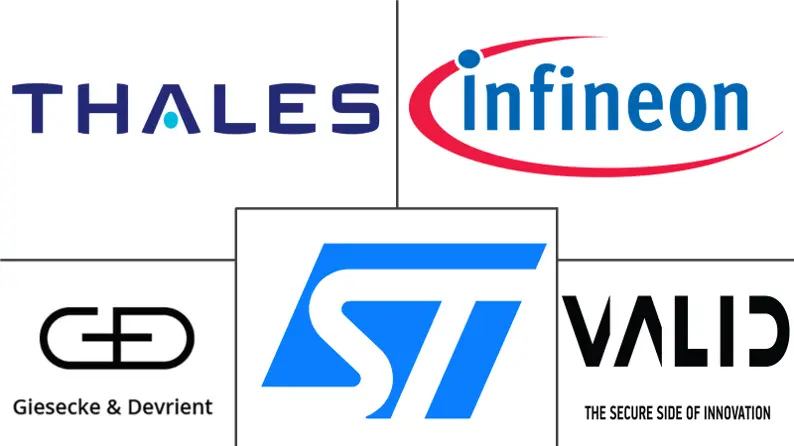Embedded SIM (eSIM) Market Size and Share
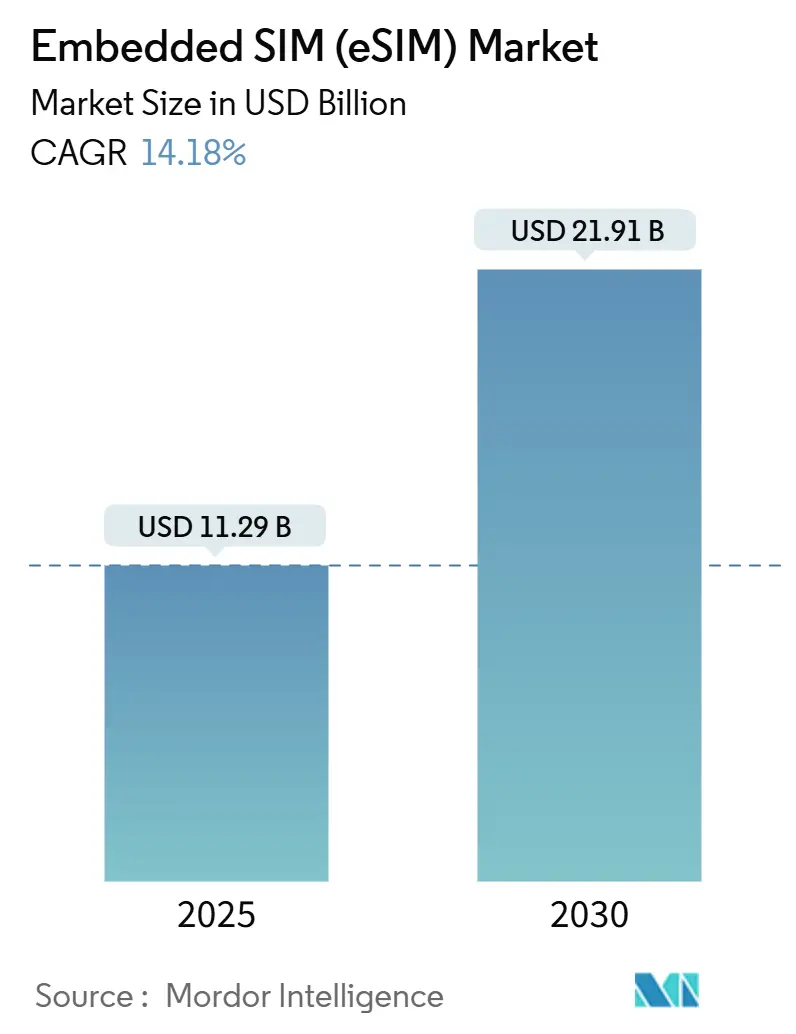
Embedded SIM (eSIM) Market Analysis by Mordor Intelligence
The Embedded SIM market stands at USD 11.29 billion in 2025 and is forecast to reach USD 21.91 billion by 2030, reflecting a 14.18% CAGR. This trajectory signals the technology’s decisive shift from niche deployments to broad-based integration across smartphones, IoT modules, vehicles, and industrial devices. Fast 5G roll-outs, the mainstreaming of eSIM-only flagships, and an expanding base of IoT projects are enlarging the addressable Embedded SIM market.[1]GSMA, “eSIM: State of the Industry 2025,” gsma.com Member companies of the Trusted Connectivity Alliance shipped more than 500 million eSIMs in 2024, confirming rising demand from device makers and mobile operators. Satellite–cellular convergence is now removing the final coverage gaps that once limited global adoption, while the GSMA’s SGP.32 specification is simplifying life-cycle management for IoT devices. Together, these forces underpin the Embedded SIM market’s momentum through 2030.
Key Report Takeaways
- By device type, smartphones retained 45.2% of the Embedded SIM market share in 2024, whereas M2M/IoT modules are projected to expand at a 28.2% CAGR through 2030.
- By solution, hardware components held 60.4% of the Embedded SIM market size in 2024; software and services are set to grow at a 22% CAGR to 2030.
- By end-user industry, consumer electronics led with 51.3% revenue share in 2024, while automotive and transportation are advancing at a 27.5% CAGR to 2030.
- By network type, 4G/LTE commanded 56.4% of the Embedded SIM market size in 2024; 5G implementations show the fastest growth at 30.1% CAGR through 2030.
- By geography, North America accounted for 35.7% of 2024 revenues; Asia-Pacific is expected to post a 24% CAGR between 2025-2030.
Global Embedded SIM (eSIM) Market Trends and Insights
Drivers Impact Analysis
| Driver | (~) % Impact on CAGR Forecast | Geographic Relevance | Impact Timeline |
|---|---|---|---|
| Rapid 5G roll-outs accelerating eSIM demand | +3.2% | Global; North America and East Asia lead | Medium term (2-4 years) |
| Mandates for eCall and UN-R155 | +2.5% | Europe, North America, Japan, South Korea | Long term (≥ 4 years) |
| Apple-led shift to eSIM-only flagships | +2.8% | North America, Europe, developed Asia-Pacific | Short term (≤ 2 years) |
| Telco OPEX savings via remote provisioning | +1.9% | Global | Medium term (2-4 years) |
| Government IoT security regulations | +1.6% | Europe, North America, China | Medium term (2-4 years) |
| Satellite–cellular convergence | +2.1% | Global; high relevance in remote regions | Long term (≥ 4 years) |
| Source: Mordor Intelligence | |||
Rapid 5G roll-outs accelerating eSIM demand
5G coverage now reaches more than 50% of the world’s population, pushing device vendors to embed eSIM as the default connectivity module. The Global Certification Forum confirms that 51.7% of all smartphones certified in 2024 supported consumer Remote SIM Provisioning, up from 34.8% a year earlier. Operators are using eSIM to automate profile downloads for premium 5G plans, cutting activation times and physical SIM logistics. For IoT, 5G standalone cores let enterprises steer traffic dynamically between public and private slices, something only eSIM-based multi-IMSI designs can exploit efficiently. The net result is a direct lift to cellular hardware demand, subscriber revenue, and ultimately to the Embedded SIM market.
Mandates for eCall & UN-R155 driving automotive adoption
European eCall rules and UN-R155 cybersecurity requirements oblige carmakers to embed secure, always-on connectivity for emergency calls, over-the-air updates, and intrusion monitoring. GlobalPlatform’s 2024 Automotive Security Roundtable emphasised that eSIMs meet both resilience and audit-trace requirements for these regulations.[2]GlobalPlatform, “Automotive Security Roundtable Summary,” globalplatform.orgVehicle OEMs have therefore begun standardising on SGP.32-compliant modules with integrated profile activation, ensuring volume scalability across global production lines. As electrification and software-defined vehicles gain ground, the Embedded SIM market benefits from larger contract sizes per car and longer revenue tails from remote services.
Apple-led smartphone OEM shift to eSIM-only flagships
Apple’s removal of the physical SIM tray in recent flagships set a precedent that is rippling across Android portfolios. More than 260 operators already provide consumer eSIM services, and each new model launch boosts retail awareness. Market surveys show that mainstream users now expect a QR-code-based activation option, pressuring carriers in emerging markets to upgrade back-end systems. This network effect is shrinking the activation friction historically blamed for slow uptake, reinforcing demand on both the device and service sides of the Embedded SIM market.
Government IoT security regulations favouring soldered SIMs
IoT security mandates in the European Union, North America, and China increasingly reference tamper-resistant Secure Elements, encouraging the use of soldered eSIM hardware. The European Semiconductor Industry Association classifies eSIMs as critical Secure Elements under the Cyber Resilience Act.[3]European Semiconductor Industry Association, “Secure Elements under the Cyber Resilience Act,” eusemiconductors.eu This regulatory pull shortens procurement cycles for industrial boards pre-fitted with eSIMs, directing extra volume toward the Embedded SIM market’s hardware suppliers.
Satellite-cellular convergence unlocking global IoT roaming
Hybrid designs that integrate NB-IoT, LTE-M, and narrowband satellite links on a single eSIM are now commercially live via providers such as emnify. By guaranteeing coverage in deserts, oceans, and polar areas, these solutions open fresh opportunities in agriculture, mining, and maritime tracking. Device makers no longer need multiple SKUs for fringe geographies, simplifying logistics and amplifying the addressable Embedded SIM market.
Restraints Impact Analysis
| Restraint | (~) % Impact on CAGR Forecast | Geographic Relevance | Impact Timeline |
|---|---|---|---|
| Fragmented M2M entitlement specifications | −1.8% | Global; higher impact in emerging markets | Medium term (2-4 years) |
| Limited consumer awareness beyond premiums | −1.2% | Emerging markets; mass-market segments | Short term (≤ 2 years) |
| Supply-chain trust concerns | −1.4% | Global; high-security applications | Medium term (2-4 years) |
| Enterprise fears of operator lock-in | −1.1% | Global enterprise segment | Short term (≤ 2 years) |
| Source: Mordor Intelligence | |||
Fragmented M2M entitlement specifications
Enterprises rolling out cross-border IoT fleets still face inconsistent entitlement and compliance rules. Although the GSMA’s SGP.31 and SGP.32 frameworks lay the groundwork for harmonisation, real-world deployments must align with varying carrier APIs, certification schemes, and audit paths. The Trusted Connectivity Alliance notes that this interim complexity inflates project timelines and integration costs. Upcoming SGP.33 test specifications promise relief, yet fragmentation will linger through the medium term, trimming the Embedded SIM market’s growth potential.
Limited consumer awareness outside premium handsets
G+D research shows only 36% of global smartphone owners recognise the term “eSIM,” with familiarity skewed toward users of high-end devices. Activation journeys that rely on QR codes or carrier apps can confuse first-time buyers, especially in prepaid-heavy markets. Operators have been cautious about mass-marketing eSIMs for fear of higher churn, limiting the consumer outreach needed to unlock mainstream demand. This awareness gap slows the Embedded SIM market’s penetration into mid-tier and budget categories.
Segment Analysis
By Device Type: IoT modules outpace consumer devices
Smartphones accounted for the largest 45.2% slice of 2024 revenues, yet M2M/IoT boards will dominate incremental demand as they grow at a 28.2% CAGR to 2030. That trajectory lifts the Embedded SIM market size for modules at a markedly faster clip than for handsets. SGP.32 removes the need for user interfaces, letting integrators batch-load profiles during manufacturing and switch carriers remotely during field operations. Wearables, tablets, and laptops add incremental volume, especially in enterprise mobility bundles that favour soldered Secure Elements for theft deterrence.
The convergence of cellular and satellite links is particularly transformative for agriculture, mining, and environmental monitoring. Providers such as Skylo certify single-SKU chipsets that roam seamlessly between terrestrial NB-IoT and narrowband NTN satellite, reducing capex for global roll-outs.[4]Skylo, “NTN Connectivity for IoT Devices,” skylo.techCoupled with falling module prices, these advances reinforce the Embedded SIM market’s leadership in mission-critical IoT.
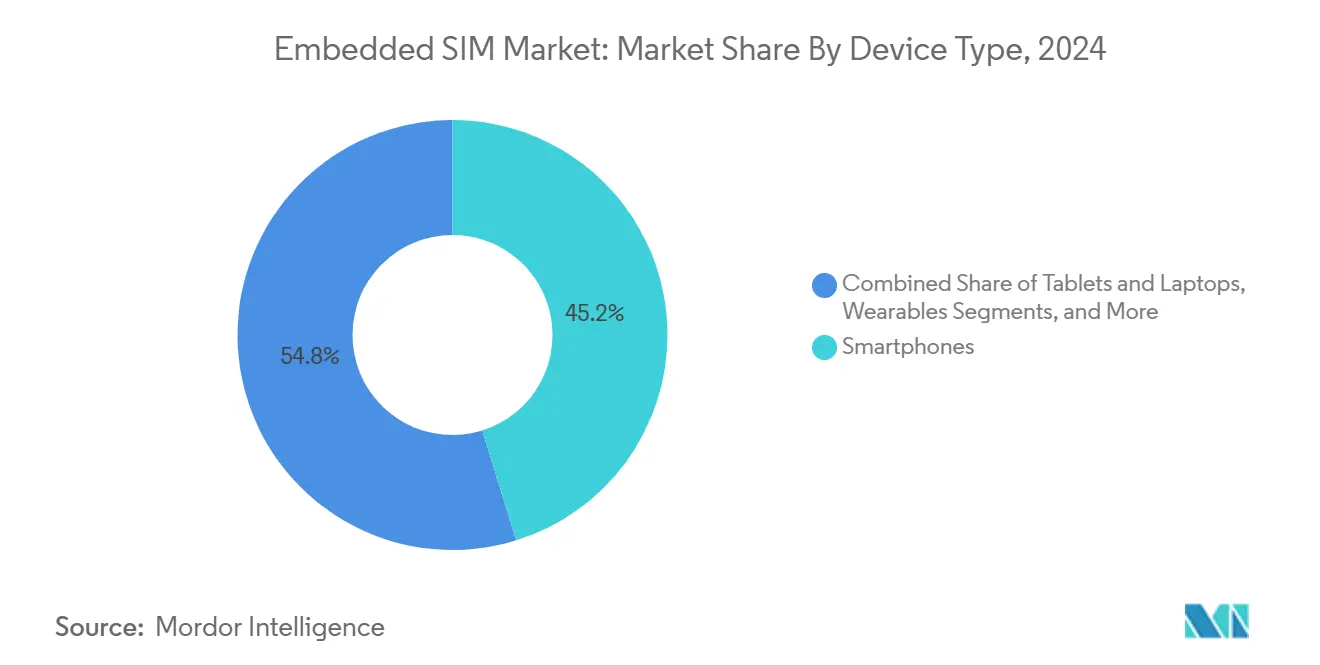
Note: Segment shares of all individual segments available upon report purchase
By Solution: Software services drive recurring revenue
Hardware still represented 60.4% of the Embedded SIM market share in 2024, yet software-centric revenue will expand faster at 22% CAGR as operators and platform vendors monetise subscription management, analytics, and cybersecurity layers. Each incremental device therefore enlarges annuity revenue, shifting value-creation away from one-off silicon sales. Amdocs’ cloud-native eSIM platform, now extended to handle Rich Communication Services on Android, exemplifies the pivot toward value-added orchestration.
On the hardware side, migration from MFF2 to wafer-level chip-scale packages frees board space for compact wearables and sensor tags. Meanwhile, Common Criteria EAL6+ certified Secure Elements gain traction in defence and critical-infrastructure deals. These dual trends ensure balanced growth for both halves of the Embedded SIM market.
By End-user Industry: Automotive connectivity accelerates
Consumer electronics still capture 51.3% of 2024 revenues, but automotive and transportation are advancing at 27.5% CAGR through 2030. That lift means the Embedded SIM market size for vehicles will rapidly converge with handset volumes. Carmakers rely on eSIM for over-the-air firmware, predictive maintenance, and subscription-based infotainment. UN-R155 mandates have turned secure connectivity from an option to a necessity, embedding multi-profile capability into every new software-defined vehicle platform.
Industry 4.0 factories, logistics lanes, and energy utilities further widen the industrial addressable base. Smart meters, grid controllers, and asset trackers need soldered Secure Elements capable of surviving harsh environments for a decade or longer. Healthcare wearables add growth by enabling continuous patient monitoring and emergency alerts over LTE-M. Altogether, these applications create a multi-sector demand pipeline that diversifies the Embedded SIM market beyond smartphones.
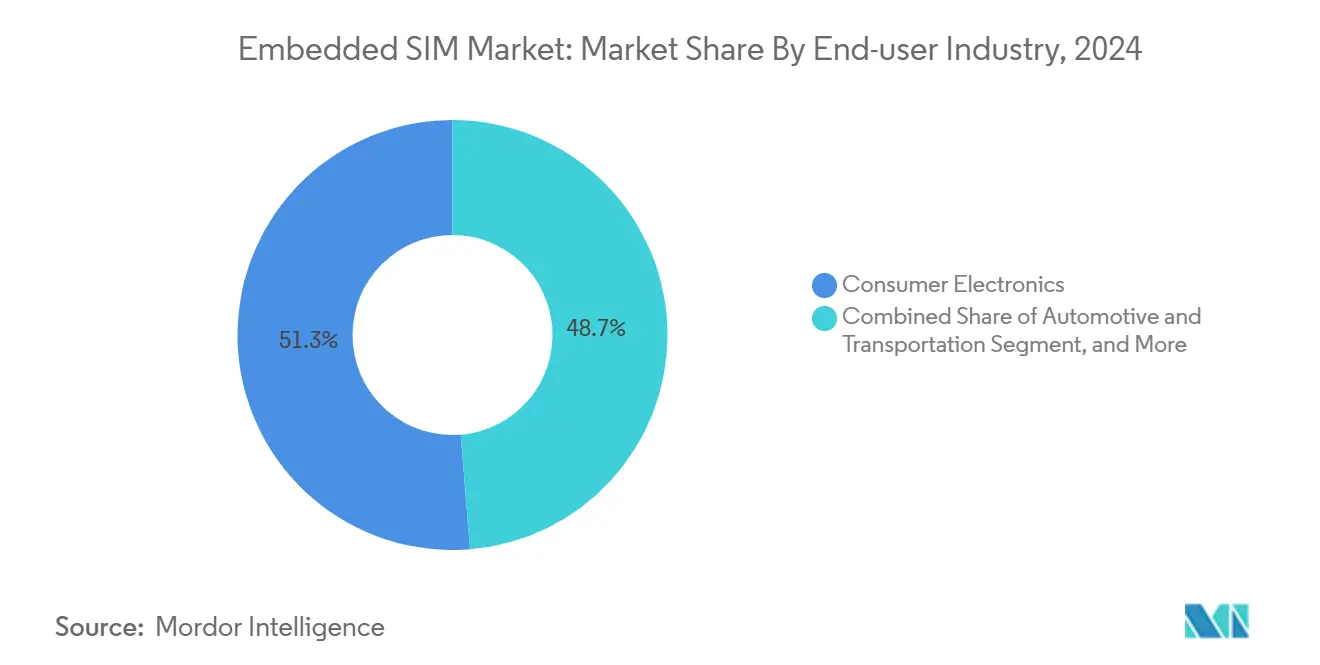
Note: Segment shares of all individual segments available upon report purchase
By Network Type: 5G drives premium connectivity
4G/LTE maintained a dominant 56.4% share of the Embedded SIM market size in 2024, yet 5G-ready Secure Elements will post a 30.1% CAGR to 2030 as standalone cores multiply. Ultra-reliable low-latency modes and network slicing require profile agility best delivered via eSIM. Ericsson forecasts strong uptake for massive IoT profiles on NB-IoT and LTE-M, networks where long battery life is paramount. Multi-profile devices that hop between 5G, LTE, and NB-IoT therefore underpin the fastest-growing segment of the Embedded SIM market.
Geography Analysis
North America captured 35.7% of 2024 revenues, with the United States alone projected to reach 90% smartphone eSIM penetration by 2030. Apple’s early shift to tray-less designs, coupled with robust carrier support, placed the region in a leadership position. Verizon’s Global IoT Orchestration service, which covers 200 territories on a single profile, illustrates the advanced service layer now standard across the Embedded SIM market.
Asia-Pacific is the fastest-growing arena at a 24% CAGR to 2030. China, Japan, and South Korea top the adoption charts, buoyed by heavy 5G investment and smart-city programmes. India’s vast subscriber base is climbing the learning curve as mid-tier phones gain eSIM slots. Regional automakers have standardised connected-car architectures around Secure Elements to meet both safety and infotainment requirements, accelerating volume growth in the Embedded SIM market.
Europe benefits from harmonised regulatory and privacy frameworks that favour remote-provisioned Secure Elements. BEREC expects one-third of smartphones in the European Economic Area to sport eSIM by 2025. Operators across Germany, France, and the Nordics roll out tourist eSIM bundles that cut roaming costs, while industrial OEMs increasingly specify SGP.32 for cross-border asset tracking. Combined, these initiatives keep Europe as a steady contributor to the Embedded SIM market expansion.
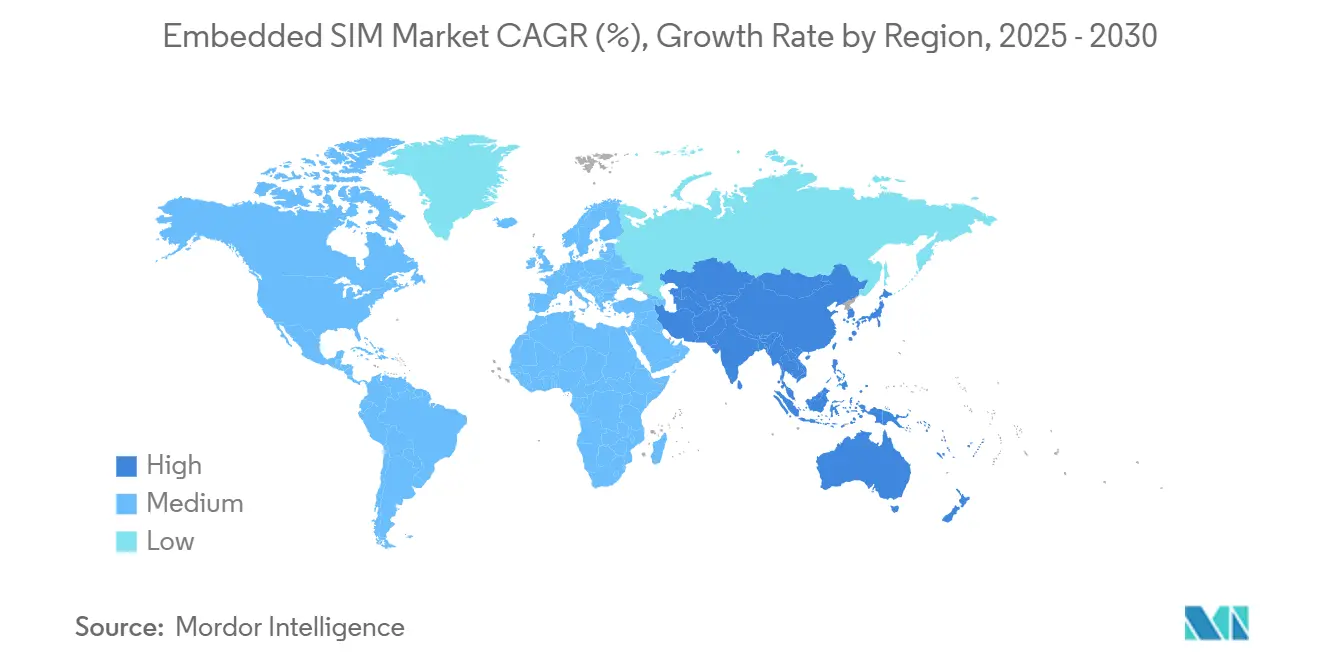
Competitive Landscape
The competitive field is moderately concentrated, anchored by long-established Secure Element specialists such as G+D, Thales, and IDEMIA. Semiconductor vendors STMicroelectronics, Infineon, and NXP integrate Secure Elements directly into modem chipsets, tightening hardware-software alignment. Cloud hyperscalers join forces with SIM incumbents - AWS and G+D recently teamed up to streamline large-scale profile downloads for global enterprises.
White-space opportunities lie in the fusion of satellite and cellular connectivity. Skylo and emnify market single-SKU modules that bridge NB-IoT and narrowband-NTN, capturing early mover advantage in agriculture and maritime IoT. Trasna pursues an integrated chip-to-cloud pathway aimed at reducing vendor sprawl, appealing to cost-sensitive industrial OEMs. As service revenue overtakes hardware margins, competition pivots toward orchestration platforms, cybersecurity add-ons, and application-layer analytics, reinforcing the Embedded SIM market’s shift to recurring-revenue models.
Embedded SIM (eSIM) Industry Leaders
-
Giesecke+Devrient GmbH
-
STMicroelectronics N.V.
-
Infineon Technologies AG
-
Valid S.A.
-
Thales Group
- *Disclaimer: Major Players sorted in no particular order
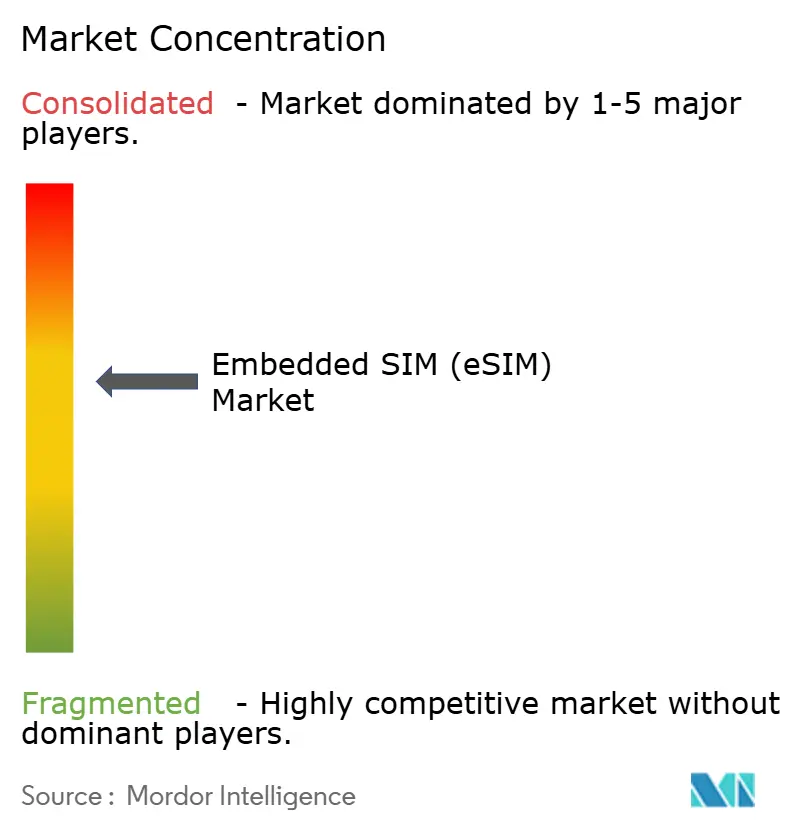
Recent Industry Developments
- May 2025: GCT Semiconductor and Giesecke + Devrient launched an SGP.32 eSIM solution with Integrated Profile Activation Device support, optimising multi-network IoT connectivity.
- May 2025: Digital bank N26 entered telecoms by rolling out eSIM mobile plans in Germany, illustrating fintech-telco convergence
- April 2024: Telenor IoT unveiled a ‘future-proof’ SGP.32 eSIM aimed at headless devices, slated for commercial release in autumn 2025.
- April 2025: River acquired Wind to bolster its eSIM and stablecoin super-app after surpassing USD 10 million ARR.
Research Methodology Framework and Report Scope
Market Definitions and Key Coverage
Our study defines the embedded SIM (eSIM) market as the worldwide value generated when remotely provisioned, GSMA compliant eUICC chips are sold pre-soldered inside smartphones, wearables, PCs, IoT modules, and connected vehicles, together with the cloud management software that activates and updates profiles over cellular networks. Value from traditional removable SIM cards, proprietary iSIMs still in pilot, and pure connectivity data plans is excluded.
(Scope exclusions: We do not count revenue from legacy plug-in SIM cards, stand-alone M2M connectivity contracts, or proprietary embedded secure elements that lack eUICC support.)
Segmentation Overview
- By Device Type
- Smartphones
- Tablets & Laptops
- Wearables
- M2M/IoT Modules
- By Solution
- Hardware eSIM (MFF2, Wafer-Level CSP etc.)
- eSIM Management Software & Services
- By End-user Industry
- Consumer Electronics
- Automotive and Transportation
- Industrial and Manufacturing
- Logistics and Asset Tracking
- Energy and Utilities
- Healthcare and Wearables
- By Network Type
- 5G
- 4G/LTE
- NB-IoT / LTE-M
- By Geography
- North America
- United States
- Canada
- Mexico
- South America
- Brazil
- Argentina
- Rest of South America
- Europe
- United Kingdom
- Germany
- France
- Italy
- Spain
- Russia
- Rest of Europe
- Asia-Pacific
- China
- Japan
- South Korea
- India
- Rest of Asia-Pacific
- Middle East and Africa
- Middle East
- GCC Countries
- Turkey
- Israel
- Rest of Middle East
- Africa
- South Africa
- Nigeria
- Kenya
- Rest of Africa
- Middle East
- North America
Detailed Research Methodology and Data Validation
Primary Research
Interviews with mobile operators, eUICC design engineers, and automotive connectivity managers across North America, Europe, and Asia-Pacific let us validate activation rates, clarify ASP compression in mid-tier phones, and confirm forecast inflection points such as the planned shift of two leading handset OEMs to eSIM only models in 2027.
Desk Research
Mordor analysts review device production tallies from sources such as UN Comtrade customs data, GSMA Intelligence device adoption dashboards, and national telecom regulator shipment filings, then enrich them with tariff breakouts from Volza import-export data. Industry journals, patent families accessed via Questel, and company 10-Ks help us benchmark average selling prices and upcoming regulation (for instance, eCall mandates in Europe). Selected news feeds on Dow Jones Factiva track quarterly operator eSIM profile downloads. The desk sources named above are illustrative; many additional public and paid references inform our library.
Market-Sizing & Forecasting
A top-down build begins with annual production of cellular capable devices, which are then filtered through eSIM penetration ratios obtained from primary calls. Parallel supplier roll-ups of eUICC wafer shipments provide a selective bottom-up check. Key variables in our model include global 5G handset share, average eSIM attach rate in new passenger cars, monthly consumer profile downloads, IoT module ASPs, and regional smartphone replacement cycles. Multivariate regression, complemented by scenario analysis for regulatory timing, projects each driver to 2030; gaps in device counts are bridged using three-year moving averages.
Data Validation & Update Cycle
Outputs pass an internal variance screener, after which senior reviewers challenge anomalies against third-party indices. Reports refresh every twelve months, with mid-cycle revisions when events such as a major OEM eSIM only launch materially shift baselines. Before publication, an analyst re-pulls the latest shipment datapoints so clients receive our freshest view.
Why Mordor's eSIM Market Baseline Earns Decision-Maker Trust
Published figures vary because firms choose different revenue buckets, profile update assumptions, and refresh cadences.
Key gap drivers include: some studies track only hardware chips, several apply a single global ASP that ignores regional mix, and a few forecast through 2032 without revisiting 5G handset adoption curves each year, unlike Mordor's annual reset.
Benchmark comparison
| Market Size | Anonymized source | Primary gap driver |
|---|---|---|
| USD 11.29 Bn (2025) | Mordor Intelligence | - |
| USD 1.46 Bn (2024) | Global Consultancy A | Counts smartphones only; excludes IoT, autos |
| USD 11.87 Bn (2025) | Regional Consultancy B | Uses uniform ASP; no profile service revenue |
| USD 11.93 Bn (2024) | Trade Journal C | Projects forward on 2021 device mix; limited refresh cadence |
This comparison shows that by selecting the right scope, blending hardware and service streams, and refreshing inputs yearly, Mordor Intelligence delivers a balanced, transparent baseline that decision-makers can trace back to clear variables and repeatable steps.
Key Questions Answered in the Report
Why is the Embedded SIM market growing faster than conventional SIM segments?
5G network expansion, eSIM-only smartphones, and regulatory mandates for secure IoT connectivity together push device makers and operators toward embedded solutions, lifting demand across consumer and industrial verticals.
How large will the Embedded SIM market size become by 2030?
It is projected to reach USD 21.91 billion by 2030, more than doubling its 2025 value on a 14.18% CAGR.
Which region shows the highest growth rate?
Giesecke+Devrient GmbH, STMicroelectronics N.V., Infineon Technologies AG, Valid S.A. and Thales Group are the major companies operating in the Embedded SIM Market.
Which is the fastest growing region in Embedded SIM Market?
Asia-Pacific is forecast to expand at 24% CAGR during 2025-2030, driven by 5G deployments and large-scale IoT projects.
What segment will add the most new revenue?
M2M/IoT modules are set to grow at 28.2% CAGR, outpacing smartphones as the primary incremental contributor.
How does satellite–cellular convergence affect enterprise IoT strategies?
Hybrid eSIM designs remove dead-zone concerns, enabling global asset tracking and remote monitoring without multiple hardware SKUs, thereby lowering total cost of ownership.
What role do software platforms play in the Embedded SIM industry?
Cloud-based orchestration, remote provisioning and cybersecurity services generate recurring revenue and now represent the fastest-growing slice of the value chain.
Page last updated on:
